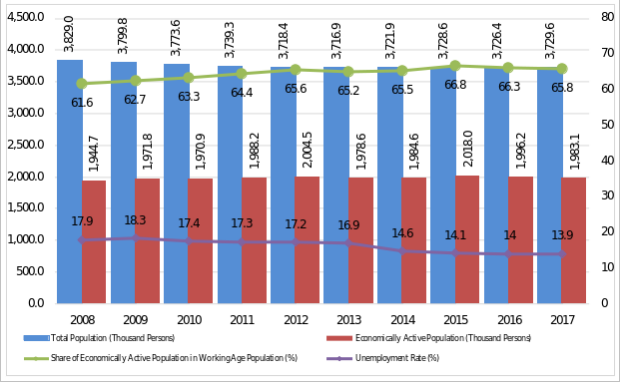Verdict: FactCheck concludes that Zurab Tchiaberashvili’s statement is TRUE whilst Giorgi Cherkezishvili’s statement is MOSTLY FALSE.
Resume: In 2017, the unemployment rate decreased by 1% and constituted 13.9%. This change, however, is stipulated not by increased employment but by a decreased workforce. The actual number of employed decreased by 10,600 (0.62%) as compared to 2016. In light of the increased number of hired employees (by 22,800), the decrease in the total number of employed is stipulated by a significant decline (by 27,900) in the self-employed component.
In terms of institutional sectors, the number of those employed in the public sector increased by 4.4% (11,900) in 2017 whilst the number of employees in the private (non-state) sector decreased by 1.6% (22,500). It is unclear what Giorgi Cherkezishvili means whilst asserting that the number of employees in the private sector increased by 32,000.
Analysis
Zurab Tchiaberashvili, MP, spoke about 2017’s employment indicators. As stated by the MP, the number of employees in the public sector increased by 4.4% in 2017 whilst, on the other hand, the number of employees in the private sector decreased by 1.6%. In response, the Deputy Minister of Economy and Sustainable Development, Giorgi Cherkezishvili, stated that the unemployment rate dropped by 0.1% in 2017 whilst employment in the private sector increased by 6% (32,000) and it was the self-employed component which had decreased.
The National Statistics Office of Georgia publishes employment figures in terms of the state (public) and non-state (private) sectors. In turn, public sector employment figures include those individuals who are employed in state and self-government bodies, state funded or state established/controlled organisations and state enterprises. The private sector includes all of those individuals who are not employed in the state sector.
In 2017, the total number of employed was 1,706,600 which constitutes a 0.6% decrease as compared to 2017. In regard to employees taken separately, the number of public service employees was 283,800 in 2017, which constitutes a 4.4% increase as compared to 2016, whilst the number of employees in the private sector decreased by 1.6% as compared to the previous year. In addition, the share of public service employment in the total employment was 16.6% in 2017 and 15.8% in 2016. The share of public service employment against the private sector was 19.9% in 2017 and 18.8% in 2016. As we see, employment in the public service has also increased in that perspective.
Graph 1: Employment Figures in 2007-2017 (Thousand Persons, %)
Source: National Statistics Office of Georgia
Even though the population did not decrease in 2017, the share of the economically active population in the total population has decreased. The unemployment rate is calculated by the employed to economically active population ratio. Therefore, the decrease in reference quantity caused the decrease in relative quantity.
In accordance with the 2017 data of the National Statistics Office of Georgia, the total number of the economically active population (workforce) is 1,983,100 which constitutes 65.8% of Georgia’s working age population. This figure decreased by 0.5 of a percentage point in 2017 as compared to 2016. In turn, a person is considered to be economically active if he is aged 15 years or more, who is employed or who was looking for a job for four weeks prior to the National Statistics Office of Georgia’s survey. This very reason stipulated the 0.1% decrease in unemployment in 2017. As Graph 1 illustrates, the number of employees decreased by 10,600 (0.62%) in 2017 as compared to 2016. In light of the increase in the number of hired employees (22,800), the decrease in the total number of employed is caused by a significant decline (27,900) in the self-employed segment.
Graph 2: Total and Economically Active Population and Unemployment Rate in 2007-2017 (Thousand Persons, %)
Source: National Statistics Office of Georgia











